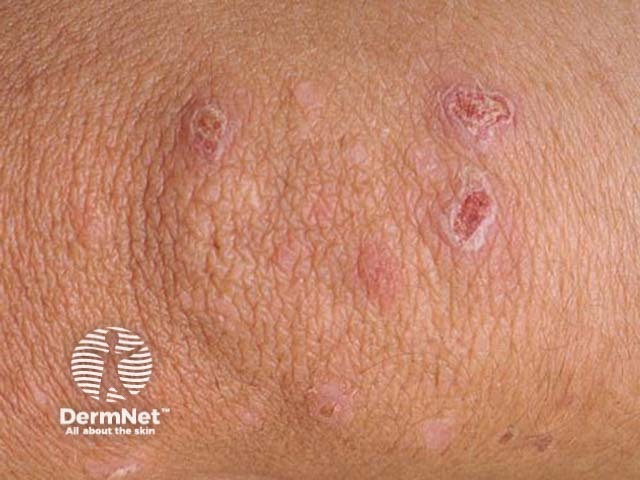Main menu
Common skin conditions

NEWS
Join DermNet PRO
Read more
Quick links
For each of the ten cases, study the image(s) and then answer the questions. You can click on the image to view a larger version if required.
Each case should take approximately five minutes to complete. There is a list of suggested further reading material at the end of the quiz.
When you finish the quiz, you can download a certificate.

What is this skin disorder?
The patient has dermatitis herpetiformis, characterised by groups of vesicles on the extensor aspects of the skin and marked pruritus.
What is the underlying cause?
Dermatitis herpetiformis is an autoimmune skin disease associated with gluten-sensitive enteropathy. Gliadin in wheat appears to be responsible.
What investigations would you recommend?
Biopsy of a new vesicle for histology and direct immunofluorescence. The characteristic histologic features are granular IgA deposits in the papillary dermis and neutrophils in the same region.
Serum for autoantibodies to gliadin and endomysium
Blood count, iron and folate studies to assess intestinal malabsorption
Small bowel biopsies Nearly all patients with dermatitis herpetiformis have villous atrophy due to gluten enteropathy (coeliac sprue). Some are symptomatic with diarrhoea, bloating and/or tiredness.
How would you treat him?
Most patients obtain excellent control with the following:
Dapsone; initial dose 50mg building up to 300mg daily if necessary, providing haemoglobin level is adequate.
If dapsone results in unacceptable side effects, sulphapyridine 1-2 g/day can be used.
Life long gluten-free diet. Many patients can significantly reduce the requirement for dapsone and are thought to minimise their risk of small bowel lymphoma.